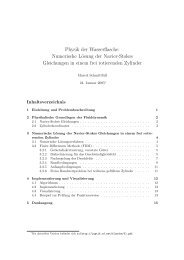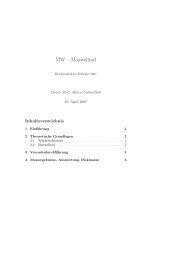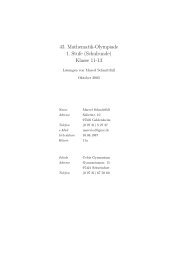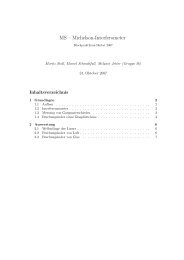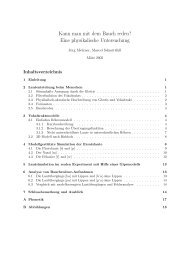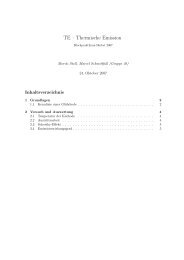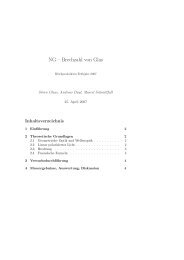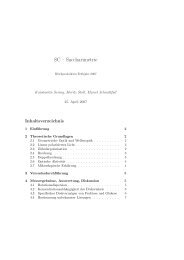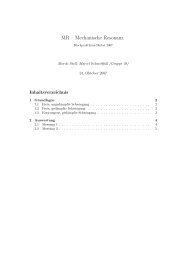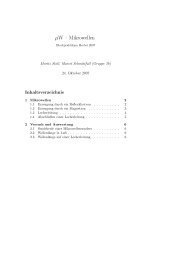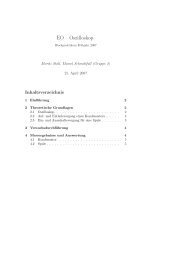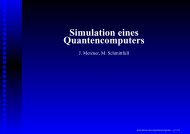JavaPsi - Simulating and Visualizing Quantum Mechanics (english)
JavaPsi - Simulating and Visualizing Quantum Mechanics (english)
JavaPsi - Simulating and Visualizing Quantum Mechanics (english)
Create successful ePaper yourself
Turn your PDF publications into a flip-book with our unique Google optimized e-Paper software.
Contents<br />
<strong>JavaPsi</strong><br />
<strong>Simulating</strong> <strong>and</strong> <strong>Visualizing</strong><br />
<strong>Quantum</strong> <strong>Mechanics</strong><br />
Marcel Schmittfull<br />
Celtis-Gymnasium Schweinfurt<br />
Germany<br />
1 Introduction 2<br />
2 Basics of quantum mechanics 2<br />
2.1 Superposition of states . . . . . . . . . . . . . . . . . . . . . . 2<br />
2.2 Indeterminism <strong>and</strong> probability interpretation . . . . . . . . . 3<br />
2.3 Heisenberg’s uncertainty principle . . . . . . . . . . . . . . . . 3<br />
2.4 Dirac’s model . . . . . . . . . . . . . . . . . . . . . . . . . . . 4<br />
3 Solving Schrödinger’s equation 4<br />
3.1 One-dimensional, time-independent case . . . . . . . . . . . . 4<br />
3.1.1 Numerov algorithm . . . . . . . . . . . . . . . . . . . . 5<br />
3.1.2 Numerical evaluation of the energy eigenvalues . . . . 6<br />
3.1.3 Free particle . . . . . . . . . . . . . . . . . . . . . . . 7<br />
3.1.4 Particle in a box . . . . . . . . . . . . . . . . . . . . . 8<br />
3.1.5 Harmonic oscillator . . . . . . . . . . . . . . . . . . . . 9<br />
3.2 One-dimensional, time-dependent case . . . . . . . . . . . . . 10<br />
3.2.1 Schrödinger’s equation . . . . . . . . . . . . . . . . . . 10<br />
3.2.2 Algorithm . . . . . . . . . . . . . . . . . . . . . . . . . 10<br />
3.2.3 Potential box . . . . . . . . . . . . . . . . . . . . . . . 11<br />
3.2.4 Potential wall <strong>and</strong> tunnel effect . . . . . . . . . . . . . 11<br />
3.2.5 Harmonic oscillator . . . . . . . . . . . . . . . . . . . . 12<br />
3.3 Two-dimensional, time-independent case . . . . . . . . . . . . 12<br />
3.4 Two-dimensional, time-dependent case . . . . . . . . . . . . . 12<br />
3.5 Radial, time-independent case . . . . . . . . . . . . . . . . . . 14<br />
4 Implementation 14<br />
4.1 Choice of programming language (Java) . . . . . . . . . . . . 14<br />
4.2 Used packages . . . . . . . . . . . . . . . . . . . . . . . . . . . 15<br />
4.3 Parameter input <strong>and</strong> user-friendliness . . . . . . . . . . . . . 15<br />
5 Status of development <strong>and</strong> download availability 16<br />
6 Future aims 16<br />
7 Acknowledges 17
2 BASICS OF QUANTUM MECHANICS 2<br />
1 Introduction<br />
The aim of this project is to simulate <strong>and</strong> visualize the behavior of particles<br />
in quantum mechanics with an interactive Java program. Almost all input<br />
data are modifiable by user interaction during runtime. In particular, the<br />
shape of the potential in which the particle ’lives’ can be entered freely<br />
by mouse <strong>and</strong> the eigenfunctions are shown by selecting the corresponding<br />
energy eigenvalues.<br />
The program computes time-dependent or time-independent solutions,<br />
either of one-, two- or three-dimensional Schrödinger equation. In the onedimensonal<br />
time-independant case the wave function is numerically calculated<br />
by the Numerov algorithm, the energy eigenvalues are found by<br />
a shooting method. The complex-valued time-dependant wave-function,<br />
which is evaluated using the Goldberg-Schey-Schwartz algorithm, can either<br />
be animated or plotted as a function of space <strong>and</strong> time, whereby the<br />
real <strong>and</strong> imaginary parts are visualized using a color map.<br />
The wave-functions of a three-dimensional spherical potential are calculated<br />
by reducing the problem to the one-dimensonal case using radial <strong>and</strong><br />
spherical eigenfunctions <strong>and</strong> solving the problem again using Numerov’s algorithm.<br />
Comparisons of the calculated wave-functions with analytical solutions<br />
of well-known potentials (e.g. free particle, simple boxes <strong>and</strong> walls, harmonic<br />
oscillator, etc.) are made <strong>and</strong> show the accuracy of the code.<br />
Especially, the program is suitable for educational purposes due to its<br />
ability to elucidate a large variety of quantum mechanical principles <strong>and</strong><br />
effects, such as wave property of particles, tunnel effects, or the behavior in<br />
arbitrary potentials.<br />
2 Basics of quantum mechanics<br />
Since the behavior of microscopic particles such as electrons <strong>and</strong> photons<br />
cannot be described by classical mechanics, quantum mechanics was developped<br />
in the beginnging of the 20th century. The following section shall<br />
introduce the basical physical background of this theory.<br />
2.1 Superposition of states<br />
One central idea of quantum mechanics is the state of a particle. In contrary<br />
to classical mechanics, it is not possible to measure all values of a state<br />
with arbitrary accuracy. For example, one cannot exactly determine the<br />
momentum <strong>and</strong> the position of a particle at the same time. Particles can<br />
be in a superposition of several states, whereby it is interesting to note that<br />
these different states of a particle may interact with each other leading for<br />
example to the interference observed in the double slit experiment. Even<br />
if only one single particle goes through the double slit, interference can<br />
be observed. Thus, the particle is in a superposition containing the ways<br />
through the two slits.
2 BASICS OF QUANTUM MECHANICS 3<br />
Now, if a particle is in a state S which is a superposition of the states A<br />
<strong>and</strong> B, one can observe that the result s, which results from a measuring of<br />
the observable O on the particle in state S, are not ’mixtures’ of the results<br />
a <strong>and</strong> b, which would result from measuring O on the particle in the states<br />
A <strong>and</strong> B respectively. Instead, s is always either completely a or completely<br />
b. Hence, when measuring V on the particle in state S, this particle ’jumps’<br />
[1] in either the state A or the state B. The states A <strong>and</strong> B, or more<br />
generally all states into which the particle can jump, are called eigenstates.<br />
The results a <strong>and</strong> b or rather all obtainable results from a measuring of O<br />
are called eigenvalues of the observable O.<br />
2.2 Indeterminism <strong>and</strong> probability interpretation<br />
Since measuring the superposition S of A <strong>and</strong> B does not yield mixtures of a<br />
<strong>and</strong> b but either a or b, it is not possible to predict the outcome of measuring<br />
of the observable O on the particle in the state S with absolute certainty.<br />
In fact one can merely say ’sometimes a <strong>and</strong> sometimes b’ with absolute<br />
certainty. Due to this fact we have to give up determinism in quantum<br />
mechanics! Wheather the obtained result z is a or b can only be said by a<br />
certain probability. Hence, the position of an electron in an atom for example<br />
cannot be evaluated explicitly any more. Instead one can only evaluate the<br />
probability density P (x) for the position of the electron. Due to Born, this<br />
probability density is the absolute-square of a probability amplitude – the<br />
so-called wave function ψ(x):<br />
P (x) = |ψ(x)| 2 . (2.1)<br />
Thus, knowing the wave function ψ(x) we can calculate the probability<br />
density P (x) <strong>and</strong> find the most probable position.<br />
The probabilities P (x) = |ψ(x)| 2 still have to satisfy a confining condition,<br />
for observing the entire existing area x = −∞ to x = ∞ or rather<br />
the entire allowed area x = x0 to x = x1 one obtains the normalization<br />
condition that the sum of all probabilities has to yield 1, i.e.<br />
x1<br />
P (x)dx = 1. (2.2)<br />
x0<br />
In order to fulfill this condition the programs described in the following<br />
sections contain a short algorithm which normalizes the wave function after<br />
its actual calculation.<br />
2.3 Heisenberg’s uncertainty principle<br />
Heisenberg’s uncertainty principle says that the information about the<br />
position x of a particle has to be the more inaccurate, the more accurate<br />
the information about the momentum p of this particle is, <strong>and</strong> vice versa<br />
that the information about the momentum p must be the more inaccurate,<br />
the more accurate the information about the position x is. That is, the<br />
accuracy ∆x of the information about the position is inversely proportional
3 SOLVING SCHRÖDINGER’S EQUATION 4<br />
to the accuracy ∆p of the information about the momentum, i.e.<br />
∆x∆p ≥ /2 ( = h<br />
2π ≈ 1, 055 · 10−34 J s) (2.3)<br />
with being an universal constant. The changeover from quantum mechanics<br />
to classical mechanics means to assume ∆x∆p = 0. That is, quantum<br />
mechanics is a generalization of classical mechanics.<br />
2.4 Dirac’s model<br />
As already mentioned in section 2.1 the states of a superposition interact<br />
with each other. Now P. A. M. Dirac [1] developped a very succesful <strong>and</strong><br />
interesting mathematical framework for the description of these interactions.<br />
A state is represented by a vector in a Hilbert room. Due to Dirac<br />
these vectors are called kets <strong>and</strong> denoted by for example |S〉. All properties<br />
of a state must be contained in a ket. 1 The dual vectors of the bras which<br />
can be seen as kind of opposites of the kets are called bras <strong>and</strong> denoted by<br />
for example 〈S|. Observables are represented by linear operators. In the<br />
special case<br />
α|S〉 = a|S〉, (2.4)<br />
the linear operator α st<strong>and</strong>s only for a muliplication of the ket |S〉 with a<br />
number a, i.e. α only modifies the length of the ket but not the direction. If<br />
equation (2.4) holds, a is called eigenvalue of the linear operator α or rather<br />
of the observable corresponding to α. In this case, |S〉 is an eigenket <strong>and</strong><br />
〈S| is an eigenbra. The wave function corresponding to the eigenket |S〉 <strong>and</strong><br />
the eigenbra 〈S| is called eigenfunction. The state corresponding to |S〉 <strong>and</strong><br />
〈S| is an eigenzust<strong>and</strong>, compare section 2.1.<br />
Now, Dirac’s model defines some operations <strong>and</strong> rules for the kets <strong>and</strong><br />
bras which enable us to describe the interaction of several states or rather<br />
kets <strong>and</strong> bras observed in experiments very properly. For a more detailed<br />
description of Dirac’s model see [1].<br />
3 Solving Schrödinger’s equation<br />
3.1 One-dimensional, time-independent case<br />
In order to calculate the position probability density P (x) of a particle<br />
in quantum mechanics one needs to calculate the wave function ψ(x). In<br />
1926 Erwin Schrödinger proposed his famous differential equation, the<br />
Schrödinger equation. In the one-dimensional time-independent case it is<br />
<br />
− 2 d<br />
2m<br />
2 <br />
+ V (x) ψ(x) = E ψ(x), (3.1)<br />
dx2 <br />
H<br />
1 Compare definition of state in section 2.1.
3 SOLVING SCHRÖDINGER’S EQUATION 5<br />
where m denotes the mass of the particle <strong>and</strong> V (x) is the position-dependentpotential.<br />
The linear operator corresponding to the total energy E is denoted<br />
by H <strong>and</strong> is in analogy to classical mechanics often called Hamilton<br />
operator.<br />
Basically, the Schrödinger equation is merely a ’recipe’ which serves to<br />
describe the procedures observed in experiments very properly. The recipe<br />
says that the total energy E is always equal to the sum of kinetic energy<br />
p2 2m <strong>and</strong> potential energy V (x) – it is thus the quantum mechanical analogon<br />
to the law of conservation of energy in classical mechanics. Though this<br />
recipe can be guessed from laws of classical mechanics2 , it is – like the law<br />
of conservation of energy in classical mechanics – not completely deducable.<br />
Since analytical solutions of equation (3.1) only exist for some special<br />
potentials V (x), the following sections will primarily consider numerical approaches<br />
which are able to solve the Schrödinger equation with arbitrary<br />
potentials V (x).<br />
3.1.1 Numerov algorithm<br />
The one-dimensional time-independent Schrödinger equation (3.1) can<br />
easily be solved by using the Runge-Kutta-method. 3 Yet, there is a numerical<br />
method especially tuned for the Schrödinger equation – the socalled<br />
Numerov- or Fox-Goodwin-algorithm, which features a very good<br />
accuracy <strong>and</strong> a very high efficiency. Thus, the program uses this Numerovalgorith<br />
to solve the Schrödinger equation . It can be derived as follows.<br />
We look for a recursion or rather an iteration which evaluates beginning<br />
with two initial boundary values ψ(x − h) <strong>and</strong> ψ(x) all further ψ(x + h) of<br />
the desired wave function ψ. 4 In order to fulfill the normalization condition<br />
(2.2) the wave function ψ(x) must converge to 0 at x → ±∞. This is made<br />
sure by setting the potential the user may input into a box with infinitely<br />
high borders. Let the boundaries of the output screen be x = −xr <strong>and</strong><br />
x = xr. Then ψ(±xr) → 0 because V (±xr) → ∞. So we obtain our first<br />
boundary value ψ(±xr) = 0.<br />
The second boundary value ψ(±xr ∓ h) is arbitrary because of the normalization<br />
done at the end of evaluating the wave function. Now, in order<br />
to find the desired recursion we first transform the Schrödinger equation<br />
(3.1) to<br />
ψ ′′ (x) + F (x)ψ(x) = 0 with F (x) = 2m<br />
2 <br />
E − V (x) , (3.2)<br />
where ψ ′′ (x) is the second spatial derivative of ψ(x). Then, we approximate<br />
2 Such ways of ’guessing’ the Schrödinger equation are contained in almost every<br />
book on quantum mechanics, for example [6] p. 15f.<br />
3 In an older version of the program the Schrödinger equation (3.1) was solved with<br />
the Runge-Kutta-methode of 5th order. But unfortunately the accuracy was not contenting.<br />
4 Here h denotes not Planck’s constant but the increment of x.
3 SOLVING SCHRÖDINGER’S EQUATION 6<br />
ψ(x ± h) by the Taylor series:<br />
ψ(x + h) = ψ(x) + hψ ′ (x) + h2<br />
2 ψ′′ (x) + h3<br />
6 ψ′′′ (x) + h4<br />
24 ψ′′′′ (x) + · · · ,<br />
ψ(x − h) = ψ(x) − hψ ′ (x) + h2<br />
2 ψ′′ (x) − h3<br />
6 ψ′′′ (x) + h4<br />
24 ψ′′′′ (x) + · · · .<br />
For the sum ψ(x + h) + ψ(x − h) we obtain<br />
<strong>and</strong> hence<br />
ψ(x + h) + ψ(x − h) = 2ψ(x) + h 2 ψ ′′ (x) + h4<br />
12 ψ′′′′ (x) + O(h 6 )<br />
ψ(x + h) = −ψ(x − h) + 2ψ(x) + h 2 ψ ′′ (x) + h4<br />
12 ψ′′′′ (x) + O(h 6 ). (3.3)<br />
Remarkably, the expressions with ψ ′ (x) <strong>and</strong> ψ ′′′ (x) vanish. Since we know<br />
ψ ′′ (x) from equation (3.2), we only need an expression for ψ ′′′′ (x). (3.3)<br />
leads to<br />
ψ ′′ (x) =<br />
Generally<br />
ψ(x + h) − 2ψ(x) + ψ(x − h)<br />
h 2<br />
ψ ′′ (x) =<br />
− h2<br />
12 ψ′′′′ (x) + O(h 4 ). (3.4)<br />
ψ(x + h) − 2ψ(x) + ψ(x − h)<br />
h 2 + O(h 2 ). (3.5)<br />
Since the expression with ψ ′′′′ (x) in equation (3.3) contains the factor h 4 ,<br />
one obtains with equation (3.5), whose error order is h 2 , a total error of<br />
order h 6 what does not worsen the earlier error order. From the equation<br />
(3.2) <strong>and</strong> (3.5) follows<br />
ψ ′′′′ (x) = d2<br />
dx2 <br />
<br />
− F (x)ψ(x)<br />
F (x + h)ψ(x + h) − 2F (x)ψ(x) + F (x − h)ψ(x − h)<br />
= −<br />
h2 + O(h 2 (3.6) ).<br />
Inserting of the obtained results in equation (3.3) yields the desired iteration<br />
ψ(x + h) =<br />
ψ(x)[2 − 5h2<br />
6<br />
h2<br />
F (x)] − ψ(x − h)[1 + 12 F (x − h)]<br />
1 + h2<br />
12 F (x + h)<br />
3.1.2 Numerical evaluation of the energy eigenvalues<br />
(3.7)<br />
So we have found an algorithm for evaluating the wave function ψ(x) for<br />
an arbitrary energy E <strong>and</strong> an arbitrary 5 potential V (x). Yet, the evaluated<br />
wave function ψ(x) satisfies the boundary condition ψ(±xr) = 0 usually<br />
only at one boundary, namely the boundary one used for the initial value<br />
of ψ. At the other boundary either ψ(−xr) or ψ(xr) diverges to ±∞. The<br />
wave function ψ(x) satisfies the boundary condition at both boundaries only<br />
5 Arbitrary except for the boundaries which must be set to infinity.
3 SOLVING SCHRÖDINGER’S EQUATION 7<br />
then, if the chosen energy E is an energy eigenvalue En. The problem of<br />
finding these eigenvalues is often referred to as two point boundary value<br />
problem. The very good efficiency of the Numerov algorithm suggests the<br />
so-called shooting-method 6 for finding the energy eigenvalues En.<br />
The shooting method works as follows. If we choose the initial values of<br />
psi at ψ(−xr) = 0 <strong>and</strong> ψ(−xr + h) = arbitrary, we simply have shots on the<br />
energy E. If ψ(x) diverges to +∞ or −∞ for big x, our shot was an error<br />
<strong>and</strong> we have to modify E. This is repeated until ψ(x) converges to 0 for big<br />
x. Observing ψ(x) for big x with different energies E, one recognizes that<br />
around an energy eigenvalue En the right boundary of ψ(x) changes its sign<br />
from +∞ to −∞ or vice versa. This change of sign also leads to a change of<br />
the number n of null points in ψ(x). Now, by counting the number n null<br />
points of ψ(x) 7 one can associate every trial energy value E with a certain<br />
n. Generally, a higher number n of null points indicates a higher energy<br />
E. More detailed, every eigenfunction ψn(x) possesses exactly one more<br />
null point than its preceding eigenfunction ψn−1(x). Thus, we first need to<br />
search 8 for two energy values E whose number n of null points differs by<br />
exactly 1. Between these two energy values lies exactly one energy eigenvalue<br />
En which can be arbitrarily accurately approximated by further use of the<br />
bisection method. By repeating this procedure one obtains all desired energy<br />
eigenvalues En.<br />
3.1.3 Free particle<br />
In order to check the results of the Numerov algorithm <strong>and</strong> the shooting<br />
method we regard the special case of a free particle since in this case the<br />
wave function <strong>and</strong> the energy eigenvalues can be obtained analytically.<br />
The potential of a free particle is V (x) = 0 for all x. From equation (3.1)<br />
we obtain<br />
− 2<br />
2m<br />
The total energy E becomes<br />
d2 ψ(x) = E ψ(x). (3.8)<br />
dx2 E = V + Ekin = Ekin = p2<br />
2m ,<br />
where m denotes the mass <strong>and</strong> the p the momentum of the particle. Assuming<br />
p = k (k wavenumber) in all points x we obtain<br />
Thus equation (3.8) implies<br />
E = 2k2 . (3.9)<br />
2m<br />
d 2<br />
dx 2 ψ(x) + k2 ψ(x) = 0. (3.10)<br />
6 See e.g. [4] S. 757ff.<br />
7 This procedure of counting the points where ψ(x) = 0 holds is implemented by count-<br />
ing the number of changes of sign in ψ(x).<br />
8 E.g. by using the bisection method.
3 SOLVING SCHRÖDINGER’S EQUATION 8<br />
The solutions of this equation are e ikx <strong>and</strong> e −ikx . Unfortunately these solutions<br />
don’t satisfy the normalization constrainment (2.2) because<br />
|ψ(x)| 2 = ψ ∗ (x)ψ(x) = e −ikx · e ikx = 1 (3.11)<br />
holds for all x. The probability for the particle being at the point x is<br />
equal for all x, namely 1. That is the position of the particle is completely<br />
unknown, ∆x → ∞. Then, according to Heisenbergs uncertainty principle<br />
(2.3) the momentum p can be determined exactly, ∆p → 0. This Dies stimmt<br />
mit der in equation (3.9) gemachten Bedingung p = k überein.<br />
Whatsoever there are several possibilities to satisfy the normalization<br />
constrainment (2.2) despite equation (3.11). One such possibilitie is Dirac’s<br />
δ function9 :<br />
∞<br />
δ(x)dx = 1<br />
−∞<br />
(3.12)<br />
δ(x) = 0 für x = 0.<br />
But since the δ function is no real methematical function 10 another solution<br />
of the problem migth be better. Since a linear combination of two solutions<br />
always yields another solution we form the linear combination<br />
ψ(x) = Ae ikx + Be −ikx<br />
(3.13)<br />
in order to satisfy the normalization constraint (2.2). The coefficients A<br />
<strong>and</strong> B of this linear combination can be obtained from the boundary conditions.<br />
In order to assure the existence of such boundary conditions in the<br />
program the potential which can be modified by the user is set into a high<br />
umgebendes äußeres potentials, i.e. in a potential box with infinite high<br />
boundaries. Thus the particle is not completely free any more, but only free<br />
in a certain area (the inner area of the big potential box). Unfortunately this<br />
constraint cannot be avoided because of the mentioned problem ∆x → ∞<br />
for a completely free particle. 11<br />
3.1.4 Particle in a box<br />
Setting the free particle potential in a box with two infinitively high boundaries,<br />
i.e.<br />
<br />
0 for 0 ≤ x ≤ a<br />
V (x) =<br />
(3.14)<br />
∞ else,<br />
leads to two boundary conditions ψ(0) = ψ(a) = 0. So we are able to<br />
calculate the coefficients A <strong>and</strong> B in equation (3.13). The normalized wave<br />
function ψn(x) becomes12 ψn(x) =<br />
2<br />
a<br />
nπ<br />
sin x (n = 1, 2, 3, . . . ). (3.15)<br />
a<br />
9 See [1] p. 58ff.<br />
10 Usually, every x-value of a function must be associated with at most on y-value.<br />
11 This constraint was also necessary for the Numerov algorithm in section 3.1.1<br />
12 For details see almost every book on quantum mechanics, e.g. [2] oder [6].
3 SOLVING SCHRÖDINGER’S EQUATION 9<br />
As Figure 1 shows, the numerical solution obtained by the Numerov algorithm<br />
is very close to this analytical solution.<br />
With equation (3.9) the total energy E becomes<br />
E = Ekin = 2 k 2<br />
2m = n2 π 2 2<br />
2ma 2 ≡ En. (3.16)<br />
Since n = 1, 2, 3, . . . we obtain only the values E1, 4E1, 9E1. . . as possible<br />
total energy En, i.e. the energy is quantisized. 13 This quantisation of the<br />
energy E can be explained by the fact that only certain values En satisfy<br />
the Schrödinger equation<br />
H|En〉 = En|En〉<br />
in such a way that the kets |En〉 are eigenkets.<br />
3.1.5 Harmonic oscillator<br />
A particle in the harmonic oscillator potential V (x) = 1<br />
2 kx2 is another<br />
important example because of its big role in molecule physics. From the<br />
Schrödinger equation<br />
− 2<br />
2m<br />
<br />
k<br />
one obtains with ω =<br />
wave function ψn(x). 14<br />
d2 1<br />
ψ(x) +<br />
dx2 2 kx2ψ(x) = E ψ(x) (3.17)<br />
m , ξ = mω<br />
<br />
x <strong>and</strong> n = 1, 2, 3, . . . the normalized<br />
ψn(ξ) = n!2 n√ π −1/2 Hn(ξ) e −ξ2 /2 , (3.18)<br />
where Hn(ξ) are the Hermite polynomials n-th degree. For the energy eigenvalues<br />
En one obtains<br />
<br />
En = ω n + 1<br />
<br />
, n = 1, 2, 3 . . . . (3.19)<br />
2<br />
That is the En are equidistant. Exactly the same result shows the output<br />
of the Numerov algorithm <strong>and</strong> the shooting method in figure 2<br />
Interestingly to note is that the minimum possible energy E0 is not 0 as<br />
in classical mechanics, but frac12ω > 0. (Compare figure 2.) This at the<br />
first glance peculiar result can be explained by Heisenberg’s uncertainty<br />
principle (2.3). The classical minimum energy is 0 <strong>and</strong> is located at a point<br />
x where the potential energy V as well as the kinetic energy Ekin are both<br />
0. That is, at this point x the position x is known with absolute accuracy<br />
(V (x) = 1<br />
2kx2 = 0 ⇒ x = 0) <strong>and</strong> at the same time the momentum is known<br />
with absolute accuracy, too (Ekin = 0 ⇒ p = 0). Thus ∆x = ∆p = 0 what<br />
contradicts Heisenberg’s uncertainty principle ∆x∆p ≥ /2 = 0. That is<br />
13 In contrary to this the energy of a free particle (see section 3.1.3) is continuary.<br />
14 As above, the detailed calculation can be found in nearly every book on quantum<br />
mechanics.
3 SOLVING SCHRÖDINGER’S EQUATION 10<br />
E = 0 cannot be an energy eigenwert, i.e. the minimum possible energy E0<br />
has to be greater than 0.<br />
A further rather interesting effect can be seen at the wave function in<br />
figure 2. Namely, the probability |ψ(x)| 2 is greater than 0 even if the total<br />
energy E is lower than the potential energy V (x). This at the first<br />
glance very strange behavior which cannot be explained classically is basically<br />
caused by the fact that quantum mechanics postulates continuity of the<br />
wave function. In a similar way one observes the tunnel effect (c.f. section<br />
3.2.4) at potential walls.<br />
3.2 One-dimensional, time-dependent case<br />
3.2.1 Schrödinger’s equation<br />
Schrödinger’s equation in the one-dimensional, time-dependent case is<br />
<br />
− 2<br />
2m ∇2 <br />
∂Ψ(x, t)<br />
+ V (x, t) Ψ(x, t) = i<br />
∂t<br />
with complex-valued wavefunction Ψ(x, t).<br />
3.2.2 Algorithm<br />
To solve the one-dimensional, time-dependent Schrödinger equation the<br />
so-called Goldberg-Schey-Schwartz-algorithm is used. 15 The desired complexvalued<br />
wave function Ψ(x, t) is formatted in a grid:<br />
x = jɛ, j = 0, 1, . . . J,<br />
t = nδ, n = 0, 1, . . . ,<br />
Ψ(x, t) ∼ = Ψ n j . (3.20)<br />
Now we look for an iteration which calculates from the inital wave function<br />
Ψ 0 j<br />
<strong>and</strong> the potential V n<br />
j the whole wave function Ψn j :<br />
Iteration for Ψ n j :<br />
1. e1 = 2 + 2∆t 2 V1 −<br />
ej = 2 + 2∆t 2 Vj −<br />
2. Ω n j = −Ψn j+1 +<br />
x = j∆t, j = 0, 1, . . . J,<br />
t = n∆t, n = 0, 1, . . .<br />
4i ∆t2<br />
∆t<br />
4i ∆t2<br />
∆t<br />
Ψ(x, t) ∼ = Ψ n j<br />
1 − , j = 2 . . . J<br />
ej−1<br />
4i ∆t 2<br />
∆t + 2∆t2 Vj + 2<br />
3. f n 1 = Ωn1 <strong>and</strong> f n j = Ωnj + f n j−1<br />
, j = 2, . . . J<br />
ej−1<br />
4. Ψ n+1<br />
J−1 = − f n J−1<br />
eJ−1 ,<br />
Ψ n+1<br />
j<br />
Ψn+1<br />
j+1<br />
= −f n j<br />
, j = J − 2 . . . 1<br />
ej<br />
5. n = n + 1 <strong>and</strong> go to 1.<br />
15 For derivation see [5] p. 103ff.<br />
<br />
Ψn j − Ψnj−1 , j = 0 . . . J
3 SOLVING SCHRÖDINGER’S EQUATION 11<br />
For the wave function Ψn j or Ψ(x, t) being complex-valued it is reasonable<br />
to consider the visualization of complex numbers <strong>and</strong> complex functions. A<br />
very interesting discussing concerning this topic is written in chapter 1 of<br />
[7]. Additionally to the possibility of splitting the complex function into<br />
real <strong>and</strong> imaginary part the method of a color map is suggested. This color<br />
map associates every phase of the complex numbers with a certain color. At<br />
the same time the absolute value of the complex numbers is shown by the<br />
saturation of the color corresponding to the phase. This complex color map<br />
was used in the program in order to visualize the time-dependent complexvalued<br />
wave function properly.<br />
In the program, the time-evolution of the wave function is put out as<br />
animation incrementing time t or alternatively as two-dimensional functions<br />
Ψ(x, t) with time axis.<br />
3.2.3 Potential box<br />
At first the potential box is considered again, c.f. section 3.1.4. Let the<br />
inital wave function Ψ(x, 0) be a Gaussian wave packet<br />
<br />
<br />
(x − x0) 2<br />
Ψ(x, 0) = exp ikx − , (3.21)<br />
with k wave number, x0 initial position <strong>and</strong> b0 initial width. Incrementing<br />
time t yields a movement of the wave packet with velocity v = k/m (fig.<br />
4b <strong>and</strong> fig. 4e). The time-evolution also shows that the width of the wave<br />
packet gets bigger. Due to the boundary conditions Ψ(0, t) = Ψ(a, t) = 0<br />
at the walls of the box the wave packet is reflected to the middle again at<br />
x = 0 <strong>and</strong> x = a (fig. 4c <strong>and</strong> fig. 4e). These occuring reflexions at the walls<br />
lead to wild interferences at first. But after some time T the initial wave<br />
packet appears again. That is, there are destructive interferences after some<br />
time leading to periodicy of the time-evolution of the wave packet. 16<br />
3.2.4 Potential wall <strong>and</strong> tunnel effect<br />
2b 2 0<br />
If a wave packet (3.21) hits a potential wall<br />
<br />
V0 für |x| < a<br />
V (x) =<br />
0 sonst,<br />
(3.22)<br />
one can observe that the wave packet is split up into a reflected <strong>and</strong> a transmitted<br />
part. (fig. 5a <strong>and</strong> fig. 5b). A small subprogram is implemented in<br />
the program which allows to explicitly measure the reflexion <strong>and</strong> transmission<br />
coefficients R <strong>and</strong> D in respect of e.g. particle energy E, wall height<br />
V0 or box width a. Fig. 5c shows the function D(E, V0). As one sees, the<br />
transmission coefficient D is directly proportional to the box height V0. Rising<br />
the total energy E leads to a rising transmission coefficient D, nearly<br />
like the square root function.<br />
16 For a detailed discussion of this periodicy see [3] p. 146ff.
3 SOLVING SCHRÖDINGER’S EQUATION 12<br />
Interestingly to note the transmission coefficient D is still greater than<br />
0 if the wave packet hits the wall with a total energy E < V0! I.e. the<br />
probability that a particle with E < V0 is measured after the wall is greater<br />
than 0 — the particle can tunnel the wall.<br />
3.2.5 Harmonic oscillator<br />
Figures 6a until 6c show that a wave packet (3.21) in a harmonic oscillator<br />
potential (c.f. section 3.1.5) oscillates from the left to the right again <strong>and</strong><br />
again. That is the behavior of the particle here is very similar to the classical<br />
description.<br />
3.3 Two-dimensional, time-independent case<br />
Schrödinger equation :<br />
<br />
− 2<br />
2m ∇2 <br />
+ V (x, y) Ψ(x, y) = EΨ(x, y)<br />
Solution: centered space (CS) discretization <strong>and</strong> relaxation yields<br />
ψ(x, y) =<br />
with F (x) from section 3.1.1.<br />
ψ(x + h, y) + ψ(x − h, y) + ψ(x, y + h) + ψ(x, y − h)<br />
4 − h 2 F (x, y)<br />
3.4 Two-dimensional, time-dependent case<br />
Schrödinger equation :<br />
<br />
− 2<br />
2m ∇2 <br />
∂Ψ(x, y, t)<br />
+ V (x, y, t) Ψ(x, y, t) = i<br />
∂t<br />
or<br />
∂ 2 Ψ(x, y, t)<br />
∂x 2<br />
+ ∂2 Ψ(x, y, t)<br />
∂y 2<br />
+i 2m<br />
<br />
∂Ψ(x, y, t)<br />
∂t<br />
− 2m<br />
V (x, y, t)Ψ(x, y, t) = 0<br />
<br />
Solution: forward time, centered space (FTCS) algorithm. Discretization<br />
<strong>and</strong> solving the obtained system yields recursion for Ψ(x, y, t + ∆t) =<br />
Ψr(x, y, t + ∆t) + iΨi(x, y, t + ∆t)<br />
Ψr(x, y, t + ∆t) = c2V (x,y,t)Ψ∂2 r<br />
Ψi(x, y, t + ∆t) = c2V (x,y,t)Ψ∂2 i<br />
Ψ ∂2<br />
(x,y,t)+c1Ψ∂2 i (x,y,t)+c2 1Ψr(x,y,t)−c1c2V (x,y,t)Ψi(x,y,t)<br />
c2 1 +c2 ,<br />
2V (x,y,t)2<br />
(x,y,t)−c1Ψ∂2 r (x,y,t)+c2 1Ψi(x,y,t)−c1c2V (x,y,t)Ψr(x,y,t)<br />
c2 1 +c2 2V (x,y,t)<br />
r (x, y, t) = Ψr(x+∆x,y,t)+Ψr(x−∆x,y,t)+Ψr(x,y+∆y,t)+Ψr(x,y−∆y,t)−4Ψr(x,y,t)<br />
(∆x) 2<br />
Ψ∂2 Ψi(x+∆x,y,t)+Ψi(x−∆x,y,t)+Ψi(x,y+∆y,t)+Ψi(x,y−∆y,t)−4Ψi(x,y,t)<br />
i (x, y, t) = (∆x) 2<br />
with c1 = − 2m<br />
∆t <strong>and</strong> c2 = 2m<br />
2 .<br />
,<br />
,
3 SOLVING SCHRÖDINGER’S EQUATION 13<br />
fig. 1: Potentialkasten (section 3.1.4). Oben Potential mit Energie-<br />
Eigenwerten, unten Wellenfunktion.<br />
fig. 2: Harmonischer Oszillator (section 3.1.5). Die Energie-Eigenwerte sind<br />
äquidistant, vgl. equation (3.19).<br />
fig. 3: Farbcode für komplexe Zahlen (section 3.2.2).<br />
fig. 4a: Zeitlicher Verlauf eines Wellenpakets im Potentialkasten (section<br />
3.2.3).<br />
fig. 4b: Das Wellenpaket zerfließt.<br />
fig. 4c: Reflexion an den Wänden.<br />
fig. 4d: Anfangszust<strong>and</strong> wiederhergestellt.<br />
fig. 4e: Ψ(x, t) als 3D-Plot. Die Ortsachse verläuft nach rechts, die Zeitachse<br />
nach hinten.<br />
fig. 5a: Wellenpaket im Barrierepotential. Aufspaltung in Reflexion und<br />
Transmission.<br />
fig. 5b: 3D-Plot von Ψ(x, t). Die Ortsachse verläuft nach rechts, die<br />
Zeitachse nach hinten.<br />
fig. 5c: Funktion D(E, h).<br />
fig. 6a: Harmonischer Oszillator. Wellenpaket auf ist auf der linken Seite.<br />
fig. 6b: Wellenpaket befindet sich rechts. Nun wird das Wellenpaket wieder<br />
nach links laufen, hierauf wieder nach rechts, usw.. . .<br />
fig. 6c: 3D-Plot von Ψ(x, t). Die Ortsachse verläuft nach rechts, die<br />
Zeitachse nach hinten bzw. oben.
4 IMPLEMENTATION 14<br />
3.5 Radial, time-independent case<br />
The solution of the radial, time-independent Schrödinger equation is<br />
fairly difficult. Analytical solutions only exist for potentials with many<br />
symmetry properties. Whatsoever, the Schrödinger equation<br />
<br />
p2 + V (r) ψ(r) = Eψ(r) (3.23)<br />
2m<br />
<br />
H<br />
for radial potentials V (r) = V (r) can be solved numerically quite good. 17<br />
The wave function ψ(r) is split into the spherical eigenfunctions Yl,m(Θ, ϕ)<br />
(given by recursion formula) <strong>and</strong> the radial wave function ψradn,l (r)<br />
ψradn,l (r)<br />
ψ(r) = Yl,m(Θ, ϕ) . (3.24)<br />
r<br />
Scaling 2<br />
m = 1 makes it possible to reduce (3.23) to a one-dimensional<br />
problem which can be solved by Numerov’s algorithm (c.f. section 3.1.1)<br />
again:<br />
d2 dr2 ψrad(r)<br />
<br />
l(l + 1)<br />
+ 2(E − V (r)) −<br />
r2 <br />
ψrad(r) = 0. (3.25)<br />
4 Implementation<br />
<br />
F (r)<br />
Still to be translated into English. . .<br />
In diesem Abschnitt soll nun auf die konkrete Implementierung der in<br />
section 3 besprochenen Verfahren eingegangen werden.<br />
4.1 Choice of programming language (Java)<br />
Die Programme wurden in der Programmiersprache Java, die mit C++ die<br />
zur Zeit weltweit am weitesten verbreitete Programmiersprache ist, realisiert.<br />
Es ist der Trend zu beobachten, dass immer mehr Menschen Java lernen<br />
und dass Java C++ als am häufigsten verwendete Programmiersprache<br />
womöglich bald ablösen wird 18 . Die wichtigsten Vorteile von Java sind:<br />
• Die Sprache ist äußerst objektorientiert aufgebaut. Der Compiler<br />
’zwingt’ den Entwickler nahezu zu objektorientierter Programmierung.<br />
Objektorientierte Programmierung hat sich in den letzten Jahren als<br />
äußerst erfolgreich erwiesen.<br />
• Die Programme sind plattformunabhängig.<br />
17 For a more detailed description see [5] p. 50ff.<br />
18 Manche behaupten, dies sei schon heute der Fall.
4 IMPLEMENTATION 15<br />
• Es kann auf eine sehr umfangreiche Klassenbibliothek zurückgegriffen<br />
werden, die auf jedem System, auf dem Java installiert ist, verfügbar<br />
ist.<br />
• Es lassen sich ohne allzu großen Aufw<strong>and</strong> anspruchsvolle interaktive<br />
grafische Benutzeroberflächen erstellen.<br />
Konkret wurden sogenannte Java Applets programmiert, deren wichtigster<br />
Vorteil darin besteht, dass sie direkt in Webseiten integriert werden können,<br />
wodurch eine Installation entfällt.<br />
4.2 Used packages<br />
Um die Programmierung der Applets zu verkürzen, wurde auf einige Pakete<br />
zurückgegriffen. So werden die Ausgaben dreidimensionaler Funktionen,<br />
welche ja in den Abschnitten 3.2 und 3.5 benötigt werden, von den Paketen<br />
Java3D 19 und VisADuebernommmen. Diese inzwischen recht weit entwickelten<br />
Pakete zeichnen sich v.a. durch Plattformunabhängigkeit und durch<br />
sehr hohe Flexibilität aus. So können die dreidimensionalen Ausgaben in<br />
Echtzeit vom Benutzer berechnet werden. Sehr nützlich ist auch, dass<br />
Zoomen, Drehen und Verschieben (jeweils direkt mit der Maus) automatisch<br />
unterstützt wird. Die Abbildungen 4e, 5b und 6c stellen einige von<br />
Java3D und VisAD erzeugten Beispiele dar.<br />
Zusätzlich wird ein Paket zum Rechnen mit komplexen Zahlen für die<br />
in den Abschnitten 3.2.2 und 3.5 20 beschriebenen Algorithmen benötigt.<br />
Hierzu wurde auf das Paket JavaSci 21 zurückgegriffen, weil es eine sehr<br />
umfangreiche Auswahl an weiteren mathematischen Hilfsmitteln enthält, die<br />
evtl. für eine Weiterentwicklung des Projekts notwendig sein könnten.<br />
4.3 Parameter input <strong>and</strong> user-friendliness<br />
Bei der Implementierung der Programme wurde auf sehr hohe Flexibilität<br />
Wert gelegt, d.h. nahezu alle für die Berechnungen benötigten Parameter<br />
sind vom Anwender in Echtzeit regelbar. Damit das Programm dennoch<br />
nicht unübersichtlich wird, wurde es in eine sehr anwenderfreundliche grafische<br />
Benutzeroberfläche von Paul Falstad mit dessen freundlicher Genehmigung<br />
eingebettet. Die Parameter lassen sich somit mit Schiebereglern, Eingabefeldern<br />
oder Drop-Down-Listen steuern. Zusätzlich können viele Parameter direkt<br />
in der Anzeigefläche des Programms mit der Maus – z.B. durch Ziehen oder<br />
Klicken – bestimmt werden.<br />
Für das Programm ist v.a. auch ein didaktischer Nutzen angedacht.<br />
Hilfetexte sollen nicht wie meist üblich ausschließlich in separaten Fenstern<br />
oder Dateien abrufbar sein, sondern sie sollen vielmehr direkt während des<br />
Ausführens des Programms angezeigt werden. Hierbei wird nicht eine große<br />
Menge Text auf ein Mal angezeigt, sondern es werden Textabschnitte aus nur<br />
19<br />
Sun Microsystems, Inc.: Java3D. http://java.sun.com/products/java-media/3D/.<br />
20<br />
Die Komplexität wird hier von den Kugelflächenfunktionen Yl,m(Θ, ϕ), siehe [5] S.<br />
41ff., verursacht.<br />
21<br />
Hale, Mark et al.: JavaSci – A science API for Java.<br />
http://jsci.sourceforge.net/.
6 FUTURE AIMS 16<br />
wenigen Zeilen durchlaufen. Diese kleinen Textstücke sollen den Anwender<br />
Schritt für Schritt durch das Programm führen und die physikalischen Hintergründe<br />
an den Kenntnisst<strong>and</strong> des Anwenders angepasst erläutern. Sehr<br />
viel Wert soll dabei auf eine hohe Interaktivität gelegt werden, beispielsweise<br />
durch eine große Auswahl an verschiedenen Touren, die gewählt werden<br />
können, oder durch ausführliche Anleitungen, mit welchen der Benutzer<br />
verschiedene Situationen und Effekte selbst ’zusammenbauen’ kann. Um<br />
so beispielsweise zu zeigen, dass ein Teil eines Wellenpakets mit E < V0<br />
(vgl. section 3.2.4) die Potentialbarriere überwinden kann, wird der Anwender,<br />
z.B. ein Schüler, nicht einfach vor einen statischen Ausdruck des<br />
Transmissionskoeffizienten gesetzt, sondern ihm wird eine step-by-step Anleitung<br />
angeboten, nach der er die Potentialbarriere selbst zeichnen kann,<br />
das Wellenpaket selbst bestimmen und auf die Barriere losschicken kann<br />
und die Bewegung seines Wellenpakets auf seine Potentialbarriere selbst<br />
beobachten kann.<br />
5 Status of development <strong>and</strong> download availability<br />
Status of development<br />
At the moment, i.e. in May 2004, all of the above cases are implemented<br />
<strong>and</strong> the program does fairly well.<br />
Download<br />
All programs can be downloaded for free from<br />
http://javapsi.sourceforge.net/. This page also contains some<br />
additional information on the project.<br />
6 Future aims<br />
Still to be translated into English. . .<br />
Zur Zeit konzentriert sich die Arbeit darauf, die in section 3 beschriebenen<br />
Verfahren vollständig in Java Applets zu verwirklichen. Später wäre es<br />
beispielsweise möglich, verschiedene Ansätze zur physikalischen Funktionsweise<br />
eines Quantencomputers 22 mit Java Applets zu visualisieren. Zwar<br />
existieren schon Programme, die Quantencomputer simulieren, aber Programme,<br />
die Quantencomputer visualisieren, finden sich kaum. Während<br />
Simulationen von Quantencomputern dem Testen von Algorithmen für Quantencomputer<br />
dienen, ließe sich mit Visualisierungen von Quantencomputern<br />
unter Umständen die physikalische Funktionsweise optimieren. Genau<br />
hierin liegt die Herausforderung, denn Algorithmen für Quantencomputer<br />
existieren schon seit geraumer Zeit — die praktische Verwirklichung eines<br />
Quantencomputers steckt jedoch noch in den Kinderschuhen.<br />
22 Sehr interessant zu diesem Thema ist Kapitel 7 (S. 277ff) in Nielsen, Michael A.:<br />
<strong>Quantum</strong> computation <strong>and</strong> quantum information. Cambridge, 2001.
REFERENCES 17<br />
Eine weiterer Gedanke ist, das in section 2.4 vorgestellte Dirac-Modell<br />
zu visualisieren. Eine derartige Veranschaulichung am Computer existiert<br />
meines Wissens noch nicht. Das größte Problem bei der Darstellung des<br />
Dirac-Modells stellt wahrscheinlich der Hilbert-Raum dar, den man sich<br />
ja nicht vorstellen kann. Trotzdem wäre es sicher sehr interessant, Möglichkeiten<br />
zu finden, mit denen das Dirac-Modell visualisiert werden könnte.<br />
Langfristig ist auch eine Beh<strong>and</strong>lung von Mehrteilchensystemen denkbar.<br />
Mit statistischen Hilfsmitteln lassen sich Wechselwirkungen zwischen mehreren<br />
Teilchen nämlich recht gut am Computer simulieren.<br />
7 Acknowledges<br />
Special thanks to Paul Falstad, Andreas Greiner, Christian Hoffmann, Martin<br />
Kamp, Wolfgang Kinzel, Siegfried Krewald, Thomas Michelitsch und<br />
Nathan Urban for interesting explanations <strong>and</strong> discussions. Further I’d like<br />
to thank the Rotary-Club Nürnberg-Erlangen for the computer sponsoring.<br />
Last but not least I thank Christoph Groth for recommending Linux, Emacs<br />
<strong>and</strong> L ATEX.<br />
References<br />
[1] Dirac, Paul A. M.: The Principles of <strong>Quantum</strong> <strong>Mechanics</strong>. Oxford,<br />
1988.<br />
[2] Gasiorowicz, Stephen: Quantenphysik. München, 1989.<br />
[3] Kinzel, Wolfgang et al.: Physics by Computer. Heidelberg, 1998.<br />
[4] Press, William H. et al.: Numerical Recipes in C. Cambridge, 2002.<br />
[5] Schnakenberg, Jürgen: Algorithmen in der Quantentheorie und<br />
Statistischen Physik. Ulmen, 1995.<br />
[6] Schwabl, Franz: Quantenmechanik. Berlin, 2002.<br />
[7] Thaller, Bernd: Visual <strong>Quantum</strong> <strong>Mechanics</strong>. New York, 2000.



